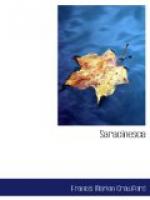The monk’s keen insight into character had given him an unexpected weapon in Corona’s defence. He knew how of all things a proud woman hates to know that where she has placed her heart there is no response, and that if she fails to awaken an affection akin to her own, what has been love may be turned to loathing, or at least to indifference. The strong character of the Duchessa d’Astrardente responded to his touch as he expected. Her tears ceased to flow, and her scorn rose haughtily against herself.
“It is true. I am despicable,” she said, suddenly. “You have shown me myself. There shall be no perhaps. I loathe myself for thinking of it. Pray for me, lest I fall so low again.”
A few minutes later Corona left the confessional and went and kneeled in the body of the church to collect her thoughts. She was in a very different frame of mind from that in which she had left home an hour ago. She hardly knew whether she felt herself a better woman, but she was sure that she was stronger. There was no desire left in her to meditate sadly upon her sorrow—to go over and over in her thoughts the feelings she experienced, the fears she felt, the half-formulated hope that Giovanni might love her after all. There was left only a haughty determination to have done with her folly quickly and surely, and to try and forget it for ever. The confessor’s words had produced their effect. Henceforth she would never stoop so low again. She was ready to go out into the world now, and she felt no fear. It was more from habit than for the sake of saying a prayer that she knelt in the church after her confession, for she felt very strong. She rose to her feet presently, and moved towards the door: she had not gone half the length of the church when she came face to face with Donna Tullia Mayer.
It was a strange coincidence. The ladies of Rome frequently go to the church of the Capuchins, as Corona had done, to seek the aid and counsel of Padre Filippo, but Corona had never met Donna Tullia there. Madame Mayer did not profess to be very devout. As a matter of fact, she had not found it convenient to go to confession during the Christmas season, and she had been intending to make up for the deficiency for some time past; but it is improbable that she would have decided upon fulfilling her religious obligations before Lent if she had not chanced to see the Duchessa d’Astrardente’s carriage standing at the foot of the church steps.
Donna Tullia had risen early because she was going to sit for her portrait to a young artist who lived in the neighbourhood of the Piazza Barberini, and as she passed in her brougham she caught sight of the Duchessa’s liveries. The artist could wait half an hour: the opportunity was admirable. She was alone, and would not only do her duty in going to confession, but would have a chance of seeing how Corona looked when she had been at her devotions. It might also be possible to judge from Padre Filippo’s




